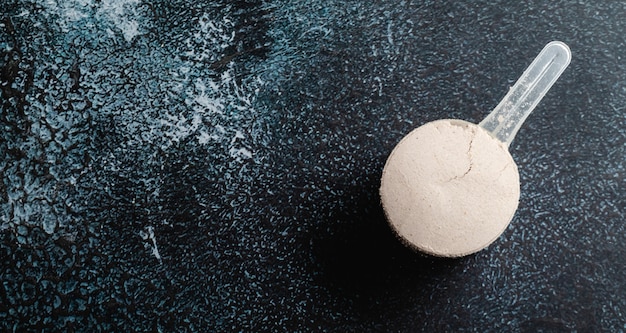Creatine Monohydrate: Maximize Strength & Power (2025 Update)

Creatine monohydrate remains a cornerstone supplement for enhancing muscle strength and power output, with continued research in 2025 reinforcing its efficacy and safety for various populations and athletic endeavors.
Unlock your peak physical performance with creatine monohydrate: Understanding Its Effects on Muscle Strength and Power Output Based on 2025 Data. This article explores the latest research, practical applications, and optimal usage of this powerful supplement.
What is Creatine Monohydrate and Why It Matters in 2025
Creatine monohydrate is a naturally occurring compound found in muscle cells. It plays a critical role in energy production during high-intensity activities. Understanding its function is key to appreciating its benefits.
The Science Behind Creatine
Creatine helps regenerate adenosine triphosphate (ATP), the primary energy currency of cells. By increasing creatine stores in muscles, individuals can enhance their ability to perform short bursts of intense activity.
In 2025, research continues to validate these mechanisms. Recent studies are focused on individual variations in creatine uptake and the potential for personalized supplementation strategies.
- ATP Regeneration: Creatine facilitates the rapid replenishment of ATP stores, crucial for power output.
- Muscle Cell Hydration: Creatine promotes water retention within muscle cells, contributing to cell volumization and strength.
- Protein Synthesis Signaling: Studies suggest creatine may positively influence pathways involved in muscle protein synthesis.
Creatine monohydrate is one of the most researched supplements in the world and has consistently been shown to be effective for increasing muscle mass, strength, and power.

Creatine Monohydrate’s Impact on Muscle Strength
One of the primary reasons athletes and fitness enthusiasts turn to creatine is its potential to boost muscle strength. Multiple studies confirm its positive effects on maximal strength and power.
In 2025, more nuanced research explores the impact of creatine supplementation on specific muscle groups and movement patterns, helping guide training protocols for optimal results.
Here are some of the proven benefits:
- Improved maximal strength in resistance training exercises.
- Enhanced power output in explosive movements like jumping and sprinting.
- Increased muscle fiber recruitment during workouts.
The increased water content in muscle cells can lead to a temporary increase in body weight, which can contribute to an increase in strength.
Power Output Enhancement: The 2025 Perspective
Beyond strength, creatine monohydrate is also celebrated for its impact on power output. Power, defined as the rate at which work is done, is crucial in many athletic disciplines.
According to data collected in 2025, creatine continues to show promise in boosting power for athletes in sports like weightlifting, sprinting, and jumping.
Creatine and Anaerobic Performance
Creatine’s capacity to replenish ATP rapidly makes it especially effective for anaerobic activities. These activities rely heavily on short bursts of power, such as sprinting or heavy lifting.
How Creatine Aids Power: Key Mechanisms
The key lies in ATP regeneration. With greater creatine stores, muscles can sustain higher levels of ATP during intense efforts, enabling athletes to generate more power.
Creatine monohydrate supplementation has been shown to improve performance in high-intensity, short-duration activities, such as weightlifting and sprinting.

Dosage and Timing: Best Practices for 2025
To maximize the benefits of creatine monohydrate, proper dosage and timing are essential. Understanding these elements ensures you’re getting the most out of your supplementation.
The Standard Creatine Dosage
The most common method involves a loading phase of 20 grams per day for 5-7 days, followed by a maintenance phase of 3-5 grams per day. This protocol helps saturate muscle creatine stores quickly.
Cycling Creatine: Is It Necessary?
While some people choose to cycle creatine, taking breaks after several weeks or months, it’s generally considered safe for long-term use at recommended dosages. The latest data from 2025 supports continuous, low-dose supplementation.
- Loading Phase: 20 grams per day for 5-7 days
- Maintenance Phase: 3-5 grams per day
- Timing: Pre- or post-workout
Recent research suggests that taking creatine post-workout, alongside protein and carbohydrates, may enhance absorption and muscle retention.
Safety and Side Effects: What the 2025 Data Reveals
The safety of creatine monohydrate has been extensively studied. Current evidence indicates that it’s generally safe for most individuals when taken at recommended dosages.
Common Misconceptions About Creatine
Despite the extensive research supporting its safety, some misconceptions persist. Debunking these myths is essential to ensure people have accurate information about creatine.
Creatine does not cause kidney damage in healthy individuals, nor does it lead to hair loss or dehydration when used responsibly.
Addressing Common Concerns:
- Kidney Health: Creatine has been shown to be safe for individuals with healthy kidney function.
- Dehydration: Staying adequately hydrated while taking creatine is important.
- Gastrointestinal Issues: Some people may experience mild stomach upset, which can often be resolved by reducing the dosage or taking creatine with food.
The 2025 data continues to reinforce these safety findings, with studies focusing on long-term usage and potential interactions with other supplements.
Creatine for Different Populations: Applications Beyond Athletes
While creatine is popular among athletes, its benefits extend beyond sports performance. Research indicates potential therapeutic applications for various populations, including older adults and individuals with certain medical conditions.
Creatine and Cognitive Function
Emerging research suggests that creatine may have cognitive benefits, including improvements in memory and processing speed. This is particularly intriguing for aging populations.
Creatine for Older Adults
Studies have shown that creatine supplementation, combined with resistance training, can help older adults maintain muscle mass and strength, improving overall quality of life.
The versatility of creatine makes it a valuable supplement for a broad range of individuals, not just elite athletes.
- Cognitive Benefits: May improve memory and processing speed
- Muscle Health: Supports muscle mass and strength in older adults
- Rehabilitation: Can aid in muscle recovery after injury
| Key Point | Brief Description |
|---|---|
| 💪 Strength Boost | Enhances maximal strength in resistance training. |
| ⚡️ Power Output | Improves power in explosive movements. |
| 💧 Muscle Hydration | Promotes water retention within muscle cells. |
| 🧠 Cognitive Function | May improve memory and processing speed. |
Frequently Asked Questions
▼
Yes, studies consistently show that creatine is safe for long-term use in healthy individuals when taken at recommended dosages. Continuous, low-dose supplementation is generally supported by the latest research.
▼
Research suggests that taking creatine post-workout, along with protein and carbohydrates, may enhance absorption and muscle retention due to increased insulin sensitivity at this time.
▼
Yes, creatine can cause temporary water retention in muscle cells, which may lead to a slight increase in body weight. This is generally considered a positive effect, contributing to cell volumization.
▼
Absolutely. Creatine is beneficial for women, supporting muscle strength, power, and even cognitive function. It’s equally effective for women as it is for men, with similar dosage recommendations.
▼
Yes, while creatine monohydrate is the most researched and commonly used form, other types include creatine ethyl ester, creatine hydrochloride (HCL), and buffered creatine. However, monohydrate remains the gold standard.
Conclusion
In 2025, creatine monohydrate continues to be a well-regarded supplement for enhancing muscle strength and power output. The latest research reinforces its safety and efficacy, solidifying its role in sports nutrition and potential therapeutic applications for diverse populations. By understanding the proper dosage, timing, and benefits, individuals can leverage creatine to achieve their fitness and health goals.





